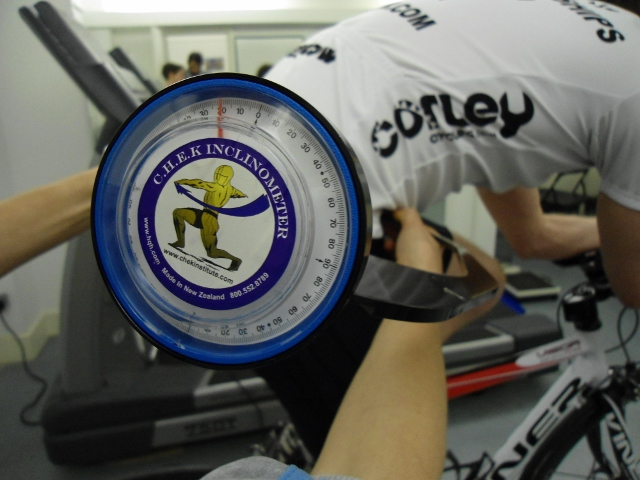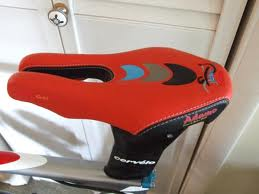It's all in the hips! Having worked with dozens of riders I am constantly reviewing and revising the biomechanical aspects influencing performance, pain issues, and style. In this first of several blogs on key ‘body’ elements of bike fitting I thought I would discuss one important measure that can affect your power and your back: Pelvic tilt.
Pelvic tilt: What is it?
I measure pelvic tilt both on and off the bike, as a key indicator of posture, possible problems and potential for movement. The position of the pelvis tells me about the tension and balance of the muscles around it, most notably those acting on the front of the pelvis and those on the back – the hip flexors and quads at the front, and the hamstrings and gluts at the back. I measure the length of these muscles too to identify any tightness/shortness that may be influencing the angle, and the potential for a rider to get into the ‘optimal’ riding position. Importantly, if the muscles at the back of your pelvis – the gluts and hamstrings – are short, they will affect your ability to bend forwards and get into a comfortable or aerodynamic position on the bike.
These measures are precise to avoid guesswork, measured by my CHEK inclinometer specially designed for the purpose. The great thing about taking this measurement on the bike is that we can change a bike position, either on your own bike or by using the bike fitting jig, and assess the impact of any changes on this all important angle. It’s good to eliminate the guesswork because sometimes you expect one thing to happen and something quite different is the result!
What does it all mean??!!
As with so many things, there is no such thing as a right or wrong angle of the pelvis per se, but there are optimal ranges for certain disciplines and types of riding. In essence, the harder you ride, the steeper the angle needs to be, and the more forward (or anterior) pelvic tilt you want. Traditionally, you would achieve this naturally by going onto the drops when you want to go hard, increasing the tilt on the pelvis by shifting forwards and down. Sometimes though a poor bike set up, or poorly fitting bike can make this impossible, and equally sometimes the muscles at the back of the pelvis are so tight they will not allow for this natural movement. Sometimes the bike is the limiting factor, sometimes it’s the body, and sometimes it is a bit of both.
In time trial terms, this innate understanding has been taken to the extreme and a lower, more forwards position is well known to be more effective for threshold type time trial efforts. This is not only about aerodynamics, but also about getting into a more powerful position. Top TT and triathlon frame manufacturers facilitate this with steep seat tube angles of up to 78 degrees, and forward sliding seat posts that can take a position even further. On the bike steeper seat tube angles facilitate increased forward (or anterior) pelvic tilt and more power.
Tech talk
The UCI 5cm rule (which stipulates that the tip of the saddle must fall 5 cm behind the bottom bracket) limits this for some cycling events, but not CTT events (which are not governed by the UCI), or triathlon events.
The Adamo saddle has become popular amongst riders not only because it takes the pressure off your private bits, but the truncated front end makes it possible to get more forwards without breaking this rule.
For smaller riders, this becomes even more important as a steeper seat tube angle is essential for the bike to fit. Emma Pooley (one of our smallest riders) has used the Adamo to get into the best position she can to essentially fit a bike which is always going to be less than ideal (More on bikes for the tall and small later on!)
Triathletes – Horses for courses
Many a cyclist or cycling bike fitter would look at a triathlon position and say – “what on earth is going on there?!! That’s far too aggressive!” But aggressive angles and high and forward saddle positions are taken to their absolute extreme by age group triathletes (who are not involved in drafting on the bike leg of their event). When you time trial and then have to get off the bike and run, an increased pelvic tilt and higher saddle keep the hip and knee angle as open as possible, making it more comfortable and less of a shock to the body. Contrary to what you might think looking at this as a cyclist, if you have the flexibility and are in good enough shape, this extreme looking position really is optimal for triathletes. But there is quite a big if in there….
A go faster position on a road or track bike
Putting the time trial/triathlon thing to one side, any rider wanting to go faster at times, whether that be racing, or just out on the road needs to get lower and push harder for all the same reasons. So the same elements apply for simply getting down onto the drops and going for it. If you have raced at all you will know that feeling of being on the tip of your saddle and biting the handlebars. This is not just about trying to reduce your drag, but is how your body can generate the most power, and your power centre is your pelvis. The difference on a road bike in particular is that the position needs to be more dynamic. At times you need to be able to go hard, and at other times you need to be more relaxed and working in an endurance position. This is naturally more ‘sat back’ with a shallower pelvic tilt to allow the more endurance orientated muscles to take over and save the power house that is your butt for when you really need it!
So why does an increased pelvis tilt help produce more power?
- Critically it facilitates the glut muscles on the down stroke as you extend your hips. Some of the most powerful muscles in the body and with more ‘fast twitch’ fibres, the gluts want to contribute more at higher intensities
- Biomechanically it reduces the distance between your pelvis and the bottom bracket by shifting your centre of gravity forwards, meaning less power is lost
- It helps you to get lower and achieve a ‘flatter’ back, reducing your frontal area and improving your aerodynamics
Next time…More about saddle height, knee angles, and what might be stopping you getting into your that faster position, and what you can do about it. You must be on the edge of your seat ![]()


